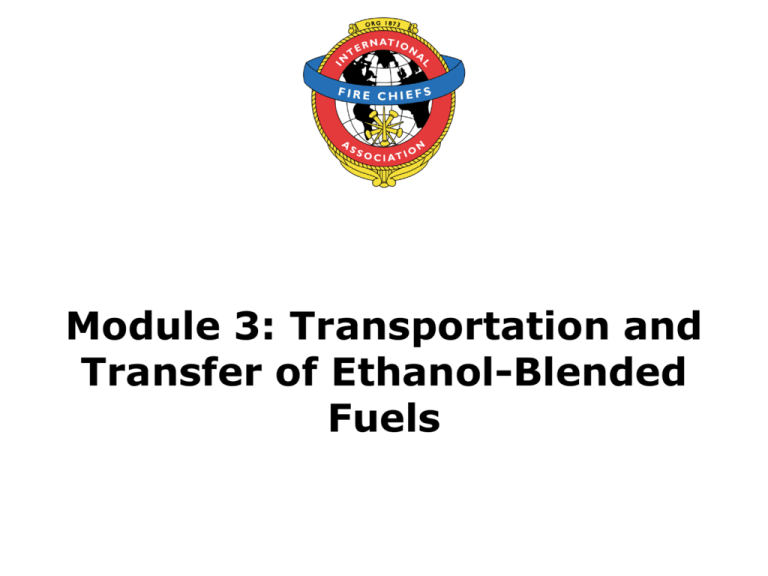Transportation and Transfer of Ethanol-Blended Fuels
advertisement

Module 3: Transportation and Transfer of Ethanol-Blended Fuels Objective Upon the successful completion of this module, participants will be able to describe how ethanol-blended fuels are transported and transferred and where the most likely points for error in these actions will exist. 2 Introduction Essential to quickly & effectively identify presence of ethanol / ethanol-blended fuels at scene of incident Can be challenging because containers in which ethanol is transported not always clearly marked Steps taken to ensure incidents managed effectively 3 Transportation and Placarding Gasoline & ethanolblended fuels transported in same general types of containers & tanks MC-306 / DOT-406 Multiple sizes & compartment configurations Local transportation issues Copyright 2006, TEEX/ESTI 4 Standard MC-306 / DOT-406 Duel axle Capacity: 6,000– 9,500 gallons Custom built 3/8 inch aluminum 1–7 compartments Property of Heil Trailers International, reprinted with permission 5 Heavy Duty MC-306 / DOT-406 Tri-axle Capacity: 9,500– 15,000 gallons Custom built 1–7 compartments Property of Heil Trailers International, reprinted with permission 6 Michigan-Style MC-306 / DOT-406 Property of Heil Trailers International, reprinted with permission Multiple axles Capacity: 13,800 gallons Custom built 5 compartments 7 Truck and Pull MC-306 / DOT-406 Truck tank: – Capacity: 4,000–6,000 gallons – 1–4 compartments Trailer tank: – Capacity: 4,000–8,500 gallons – 1–5 compartments Custom built Property of Heil Trailers International, reprinted with permission 8 Military Refueler Property of Heil Trailers International, reprinted with permission Low profile Capacity: 5,000 gallons Single compartment Built to military specifications Air transportable Property of Heil Trailers International, reprinted with permission 9 Transportation and Placarding DOT: – Classifies according to primary danger – Assigns standardized symbols to identify classes Ethanol & ethanol-fuel blends are flammable liquids Copyright ERG 10 Transportation and Placarding Flammable tanker placards: – Lower ethanol concentrations up to & including E-10 (E-01 to E-10) blended fuels: UN 1203 – E-85 (E-11 to E-94) blended fuels: UN 3475 – E-95, E-98 (E-95 to E-99) blended fuels: UN / NA 1987 – E-100: UN 1170 Copyright ERG 11 Transportation and Placarding October 1, 2008: – U.S. DOT, Pipeline and Hazardous Materials Safety Administration (PHMSA) issued final rule creating a new proper shipping name & placard for ethanol-blended fuels with a percentage higher than 10% but lower than 95% (E-11 to E-94) 12 Ethanol Proper Shipping Names Ethanol Concentration Preferred Proper Shipping Name E-1 to E-10 Gasohol (UN 1203) or Gasoline (UN 1203) E-11 to E-94 Ethanol & gasoline mixture (UN 3475) E-95 to E-99 Denatured alcohol (NA 1987) or Alcohols n.o.s. (UN 1987) E-100 Ethanol (UN 1170) or Ethyl alcohol (UN 1170) 13 Transportation and Placarding April 22, 2009: – EPA received a waiver to lift arbitrary regulatory cap on ethanol from a 10% blend of ethanol to a 15% blend of ethanol in our gas supply; must approve / disapprove by December 1, 2009 – Current cap dates back to 1970s – If approved, DOT-PHMSA will decide placarding; current debate is to placard pure hydrocarbon gasoline with UN 1203 & E-1 to E-94 ethanol-blended fuels with placard UN 3475 14 Transportation and Placarding DOT 111 rail car: – Non-pressure general tank car – Current maximum capacity 34,500 gallons Copyright 2009, IAFC 15 Transportation and Placarding Rail tanks identified similarly Pressure & vacuum relief devices same as currently found on gasoline-style transport tankers Bottom loaded & unloaded by standard 4-inch quick connect / direct connections 16 Transportation and Placarding Valving internal to tanks with breakaway piping & remote shut-off controls Vapor recovery systems same as currently found on roadway gasoline tankers 17 Standard Non-Pressure Tank Top Fittings Arrangement — Valves Copyright 2009, IAFC 18 Standard Non-Pressure Tank Top Fittings Arrangement — Manway Copyright 2009, IAFC 19 Standard Non-Pressure Tank Bottom Outlet Valve Arrangement Copyright 2009, IAFC 20 Transportation and Placarding Most fuel-grade ethanol (E-98, E-95) transported by rail: – Some by waterway & very small amounts by pipeline – Pipeline concern: corrosiveness – pH between 5 & 6 (slightly corrosive) Storage depots with no access to rail receive it by road tankers: – Trans-loading 21 Transportation and Placarding NFPA 704 diamond: – Uses colors, numbers, & special symbols to indicate presence of hazardous materials – Higher number = greater hazard 22 NFPA 704 Diamond Copyright 2008, TEEX/ESTI 23 Transportation and Placarding NFPA 704 diamond: – Health: Blue – Flammability: Red – Reactivity: Yellow – Special: White (special notice) 24 Transportation and Placarding NFPA diamond for E-100, E-98, E-95, E-85, & E-10 (gasoline): – 1: Blue health square: slight to moderate irritation – 0: Reactivity yellow square – 3: Flammability red square: high flammability with ignition likely under most conditions – No commonly accepted special character (white) 25 NFPA Diamond for E-100, E-95, E-85, and Gasoline Copyright 2008, TEEX/ESTI 26 Transportation and Placarding Most hazardous materials incidents occur during transportation & transfer operations Be aware of areas / routes where large shipments of ethanol & ethanol-blended fuels routinely pass Fuel-grade ethanol (E-98, E-95) now leading single hazardous material transported by rail Some refineries now shipping fuel fully blended 27 Transportation and Placarding Most of Midwest & other ethanol production facilities have access to rail sidings, many bulk storage fuel depots do not have rail sidings: – Much of the fuel-grade ethanol is trans-loaded to tanker trucks for distribution to bulk storage facilities via highways 28 Transportation and Placarding Placards able to indicate high-concentration ethanol-blended fuels: – Does not distinguish between gasoline & E-10 gasohol – E-10 requires AR foam for emergency response 29 Transportation and Placarding TRANSCAER: – Voluntary effort – Founded by Union Pacific & Dow Chemical – Members – Resources may include: 30 Activity 3.1 — Ethanol Spill Emergency Purpose: – To allow participants to determine the hazards associated with an ethanol emergency. 31 Summary Variety of sources for information about chemicals involved in spill / fire incidents: – – – – MSDS UN numbers DOT placards NFPA 704 placards Fuel-grade ethanol (E-98, E-95) become leading hazardous material transported by rail: – Transfer commonly occurs via highways 32





